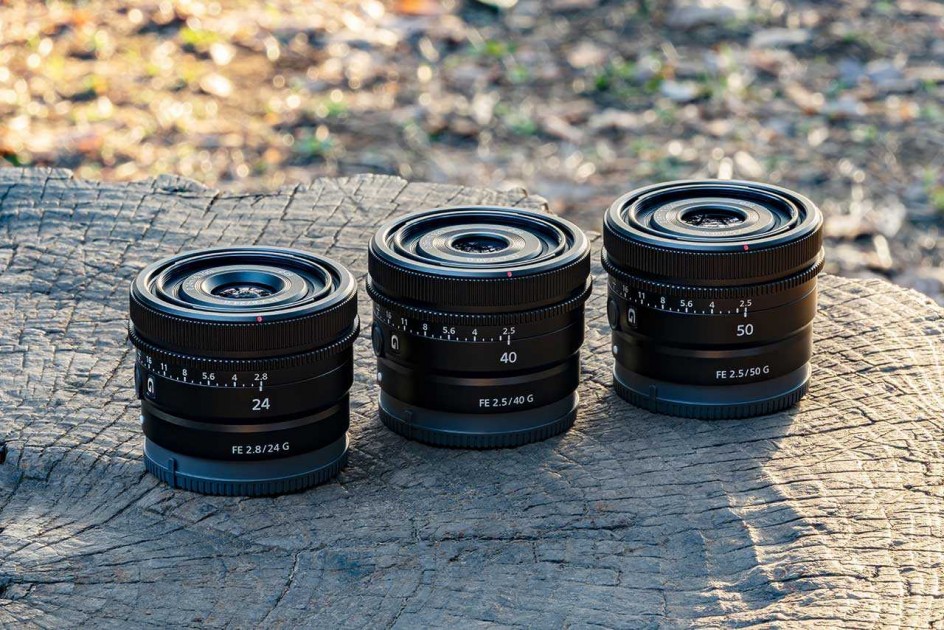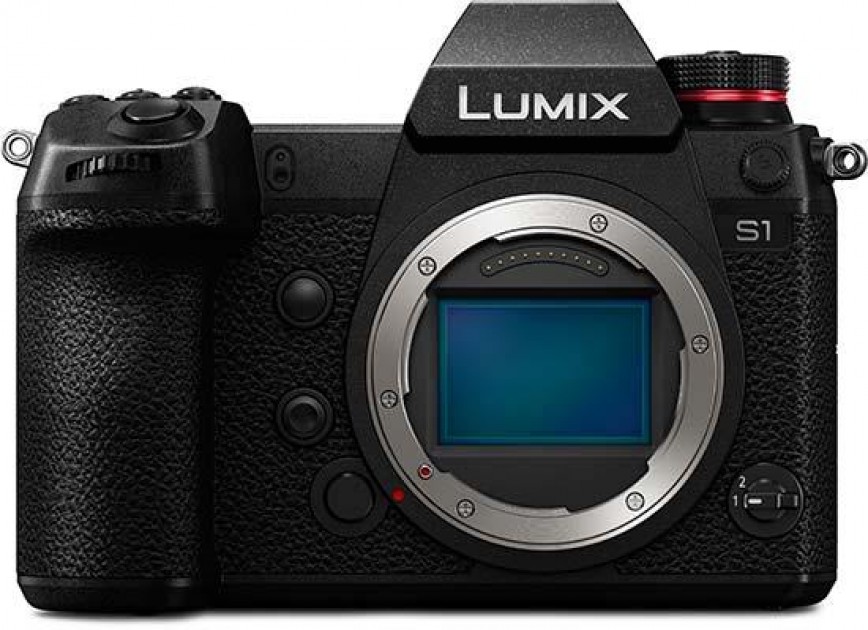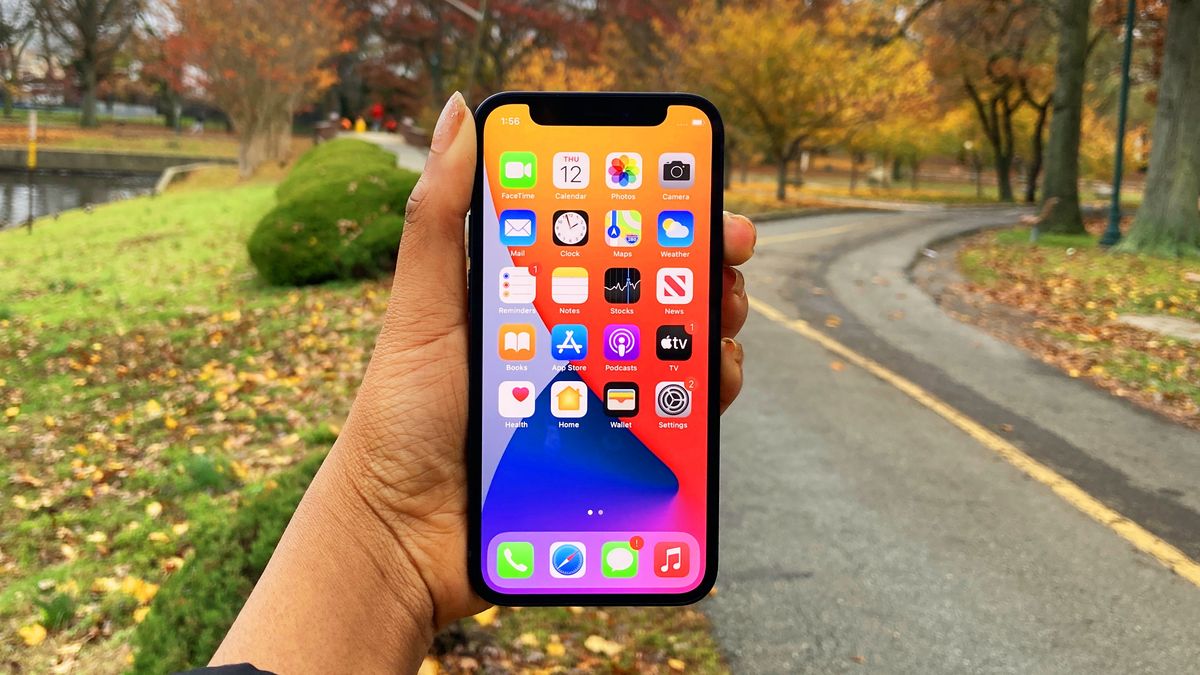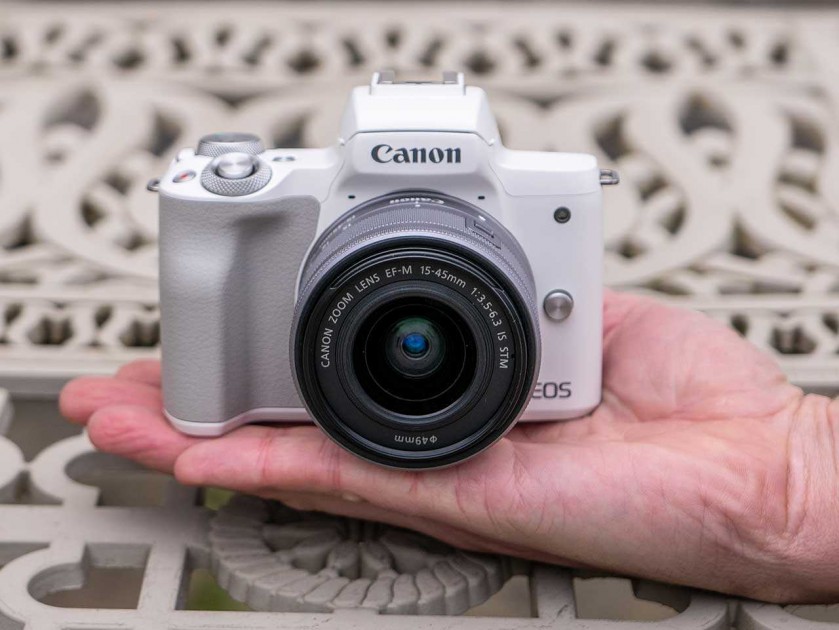

Introduction
The EOS M50 Mark II is a brand new entry-level APS-C sensor mirrorless camera from Canon.
First announced in the USA in October 2020, it was also recently introduced in the UK, Europe and Australia in Februrary 2021.
The M50 II has a 24.1 megapixel APS-C CMOS sensor and DIGIC 8 processor that provides 4K/25p video recording.
It features a 3-inch 1,040K-dot LCD vari-angle monitor with a touch-screen interface and an integrated OLED electronic viewfinder with 2.36M dot resolution.
It has a 99-point auto-focusing system, ISO range of 100-25600, integrated Wi-Fi, Bluetooth and NFC connectivity, 10fps burst shooting, support for CR3 14-bit RAW files, and both a built-in pop-up flash and a flash hot-shoe.
The Canon EOS M50 Mark II is available in white or black priced at £589.99 / €659.99 / $599.99 for the body only, in a kit with the EF-M 15-45mm IS STM lens for £649.99 / €779.99 / $699.99, or $929.99 for the camera body plus the EF-M 15-45mm and EF-M 55-200mm double zoom lens kit (US-only).
It’s slightly more expensive in the UK and Europe than the original M50 was on launch, but significantly cheaper in the US.
Ease of Use
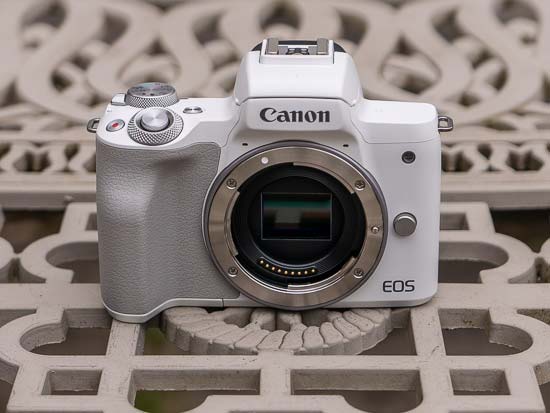
We’re not going to beat around the bush – the new Canon EOS M50 Mark II is outwardly identical to the old EOS M50, with the exception of the nameplate on the rear-left shoulder of the camera.
That’s right – this 2020/21 release is exactly the same in terms of its size, weight, design and control layout as the original 2018 model.
All of the changes (and there aren’t actually that many) have been made internally to the camera’s feature-set, with most of them on the video rather than stills side.
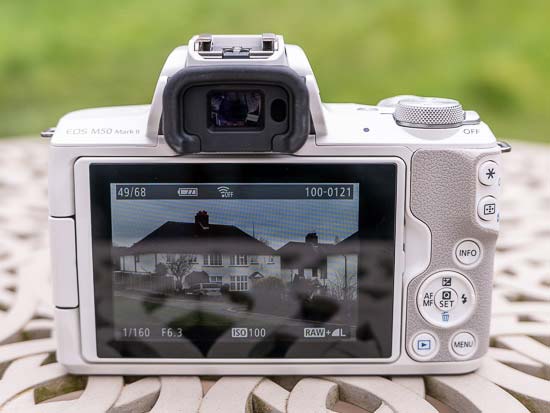
So if you were a fan of the M50 but were hoping for some significant upgrades in this new version, we’re afraid that you will be sorely disappointed, as side-by-side you would be very hard-pressed indeed to tell them apart from each other.
With that in mind, before we discuss the handful of updates that Canon have made, we’d suggest that you go and read our detailed Canon EOS M50 review first, and then come back here to learn what’s new about the Mark II version.
Right – now that you’ve done that, let’s move on to what makes the M50 II not so different to its predecessor.
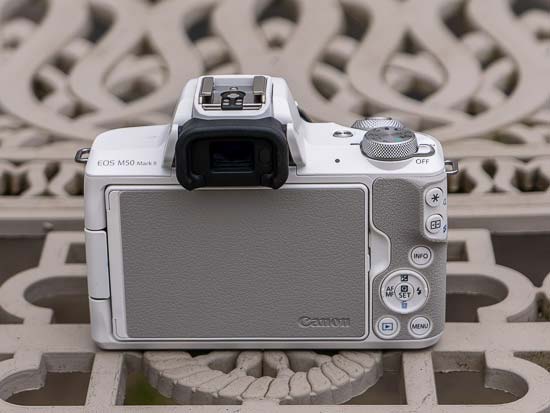
Perhaps most significantly, the M50 Mark II has improved the autofocusing for tracking a subject for both stills and video recording.
Essentially the Dual Pixel autofocus system has been updated to provide eye tracking in both shooting modes, whereas the original M50 didn’t offer this feature at all.
Toggled on or off by pressing the Info button whilst in the Face Tracking AF mode, in practice we found that it quickly detected a human subject’s eye and doggedly followed it around the frame if either the camera was moved or the subject, switching from left to right or the reverse if the subject turned their head from side-to-side.

Canon’s Dual Pixel AF system is one of the best in the business and the addition of eye-AF is the single biggest reason why we’d choose or upgrade to the M50 II. It is a shame not to see any animal or even bird eye-AF added too, although that’s probably to be expected on an entry-level camera like this one.
Also note that autofocusing during 4K recording is still only contrast-based, which is slower and less precise than the phase-detection system that’ operates in 1080p mode, disappointingly just like the original M50.
The second focusing improvement is the new to the M50-series ability to tap the LCD screen to set the focus point whilst looking through the EVF, although lots of other cameras have had this feature for a while now.
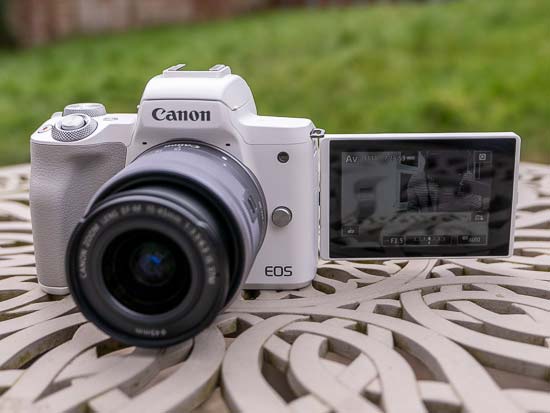
The new Mark II also enables the capture of vertical video for Instagram, TikTok and other platforms that support it, with the camera automatically switching from landscape to portrait mode when you hold the camera vertically.
Another new video feature is wireless live streaming to YouTube, although as you currently have to have 1,000 subscribers to actually be able to do this, it might have limited usage, if not appeal.
Perhaps more useful for more users is the new movie self-timer, which counts you in from either 2 or 10 seconds to allow you to compose yourself before the recording actually starts, and the newly added tap video record button which is displayed at the top-right of the LCD screen.
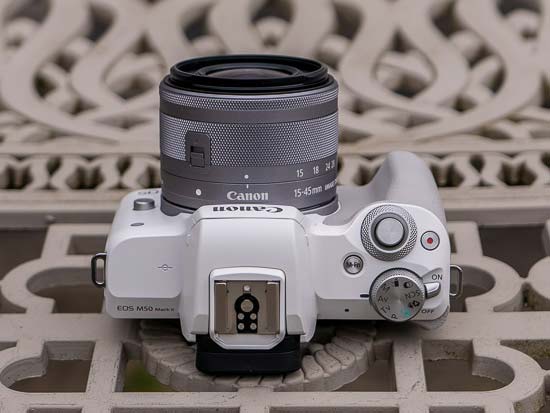
The final new feature is one born out of the Pandemic – like so many cameras in the past year, the M50 II can also operate as a high-quality webcam by using the free-to-download Canon EOS Webcam Utility or via its Clean HDMI output (enabled via the “HDMI info disp” menu option), which is also very useful for the live streaming feature.
And that’s about it for this camera’s new features – tracking them all down in the camera menu actually took longer than actually writing about them. It’s something of an understatement to say that the M50 MK II is a rather modest upgrade of the original M50, with most of the improvements aimed at videographers and especially vloggers.
Image Quality
All of the sample images in this review were taken using the 24 megapixel Fine JPEG setting, which gives an average image size of around 8Mb.
The Canon EOS M50 produced still images of excellent quality during the review period.
This camera produces noise-free JPEG images from ISO 100 all the way up to ISO 3200, with noise first appearing at ISO 6400. The faster setting of 12800 displays relatively little noise, certainly suitable for small prints and web images. We wouldn’t advise using the expanded setting of ISO 25600 though.
The built-in flash worked well indoors, with no red-eye and good overall exposure. The night photograph was very good, with the maximum shutter speed of 30 seconds and the Bulb mode allowing you to capture enough light in all situations.
The different Picture Styles and the ability to create your own are a real benefit, as are the extensive range of digital filter effects, all of which can be previewed before you take the shot.
Noise
ISO sensitivity can be set between ISO 100 and ISO 25600 in full-stop increments. Here are some 100% crops which show the noise levels for each ISO setting, with JPEG on the left and the RAW equivalent on the right.
| JPEG | RAW |
|
ISO 100 |
ISO 100 |
 |
 |
|
ISO 200 |
ISO 200 |
 |
 |
|
ISO 400 |
ISO 400 |
 |
 |
|
ISO 800 |
ISO 800 |
 |
 |
|
ISO 1600 |
ISO 1600 |
 |
 |
|
ISO 3200 |
ISO 3200 |
 |
 |
|
ISO 6400 |
ISO 6400 |
 |
 |
|
ISO 12800 |
ISO 12800 |
 |
 |
|
ISO 25600 |
ISO 25600 |
 |
 |
File Quality
The Canon EOS M50 Mark II has 2 different JPEG file quality settings available, with Fine being the highest quality option, and it also supports Raw. Here are some 100% crops which show the quality of the various options, with the file size shown in brackets.
|
Fine (6.7Mb) (100% Crop) |
Normal (3.3Mb) (100% Crop) |
 |
 |
|
Raw (27.6Mb) (100% Crop) |
|
 |
Flash
The flash settings on the Canon EOS M50 are Auto, Manual Flash On/Off, and Red-Eye Reduction. Here are some portrait shots. As you can see, neither the Flash On setting nor the Red-Eye Reduction option caused any amount of red-eye.
|
Flash Off |
 |
|
Flash On |
 |
|
Flash Off |
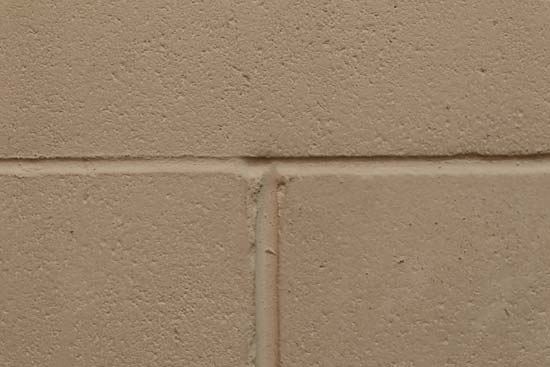 |
|
Flash On |
 |
|
Flash Off |
 |
|
Flash On |
 |
|
Flash Redeye |
 |
Night
The Canon EOS M50’s maximum shutter speed is 30 seconds and there’s a Bulb mode for even longer exposures, which is excellent news if you’re seriously interested in night photography.

Picture Styles
Canon’s Picture Styles are preset combinations of different sharpness, contrast, saturation and colour tone settings. The seven available Picture Controls are shown below in the following series, which demonstrates the differences. There are also three User Defined styes so that you can create your own look.
|
Standard |
Portrait |
 |
 |
|
Landscape |
Fine Detail |
 |
 |
|
Neutral |
Faithful |
 |
 |
|
Monochrome |
|
 |
Creative Filters
The Creative Filters shooting mode contains eight different options to help spice up your images.
|
HDR |
Fish-eye |
 |
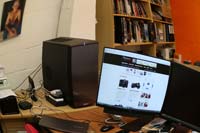 |
|
Art Bold |
Water Painting |
 |
 |
|
Miniature |
Toy Camera |
 |
 |
|
Soft Focus |
Grainy B/W |
 |
 |
Sample Images
This is a selection of sample images from the Canon EOS M50 Mark II camera, which were all taken using the 24 megapixel Fine setting. The thumbnails below link to the full-sized versions, which have not been altered in any way.
Sample RAW Images
The Canon EOS M50 Mark II enables users to capture RAW and JPEG format files. We’ve provided some Canon RAW (CR3) samples for you to download (thumbnail images shown below are not 100% representative).
Sample Movies & Video
This is a sample 4K movie at the quality setting of 3840×2160 pixels at 25 frames per second. Please note that this 20 second movie is 291Mb in size.
This is a sample 1080p movie at the quality setting of 1920×1080 pixels at 60 frames per second. Please note that this 20 second movie is 146Mb in size.
This is a sample 720p slow-motion movie at the quality setting of 1280×720 pixels at 120 frames per second. Please note that this 32 second movie is 50Mb in size.
This is a sample vertical movie at the quality setting of 3840×2160 pixels at 25 frames per second. Please note that this 17 second movie is 243Mb in size.
This is a sample 4K movie demonstrating the Eye-AF feature at the quality setting of 3840×2160 pixels at 25 frames per second. Please note that this 21 second movie is 306Mb in size.
Product Images


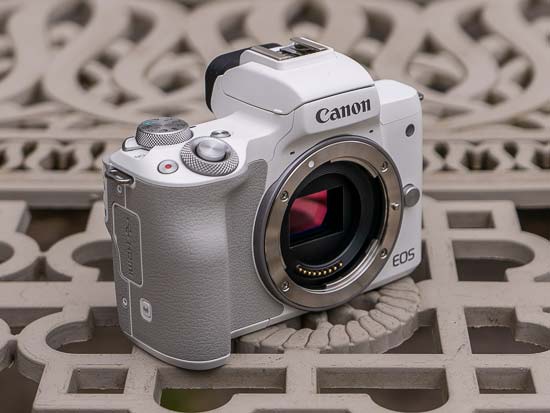
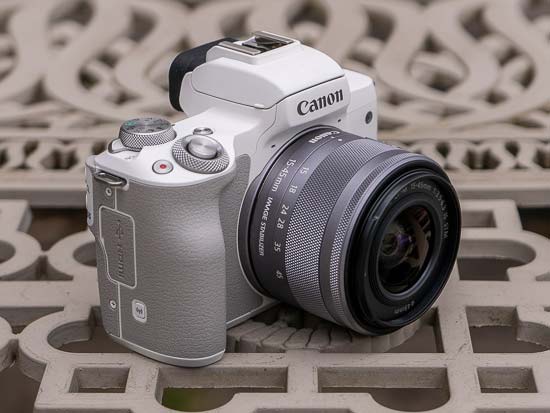
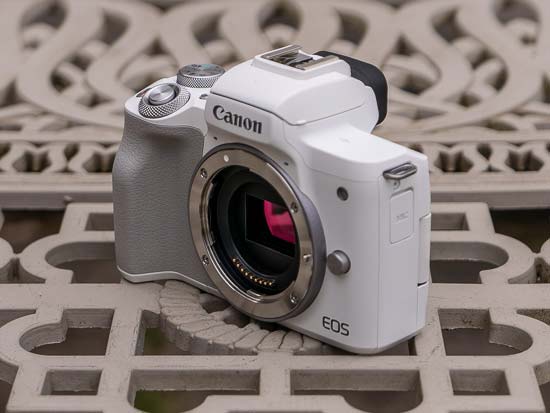
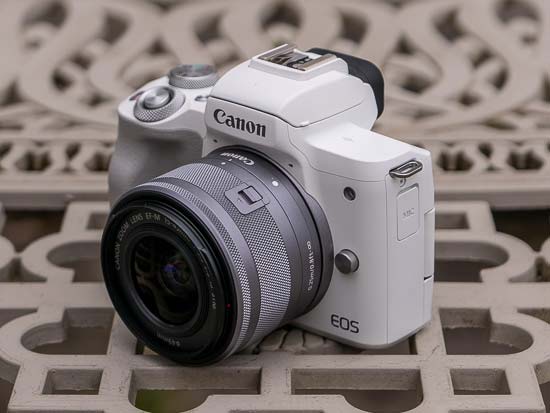



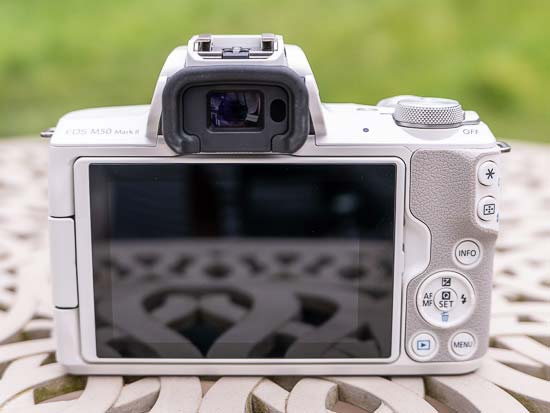
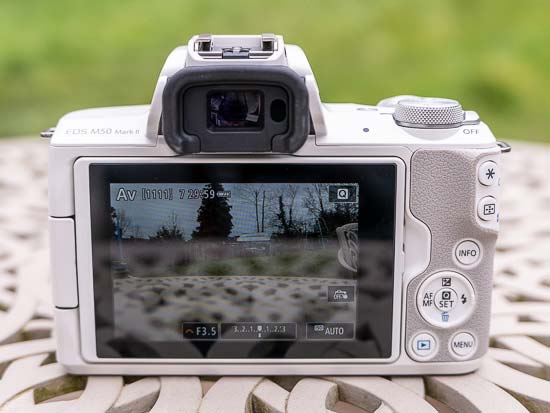


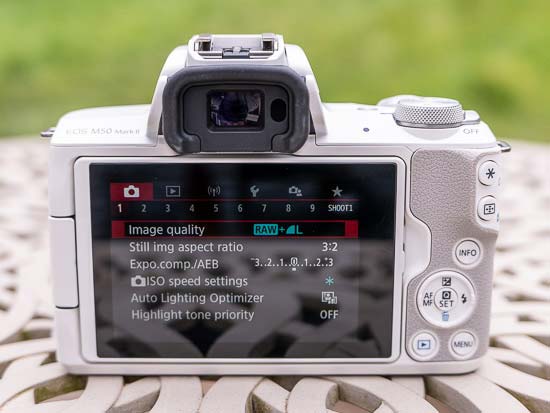

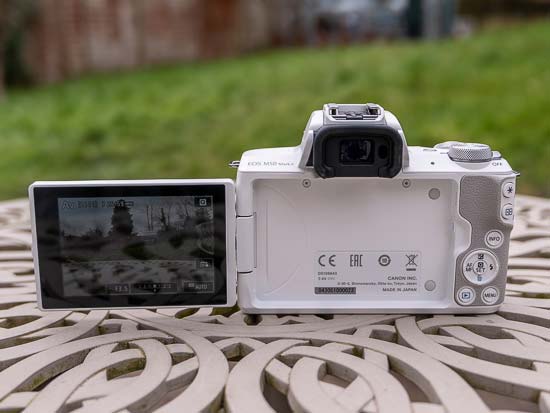


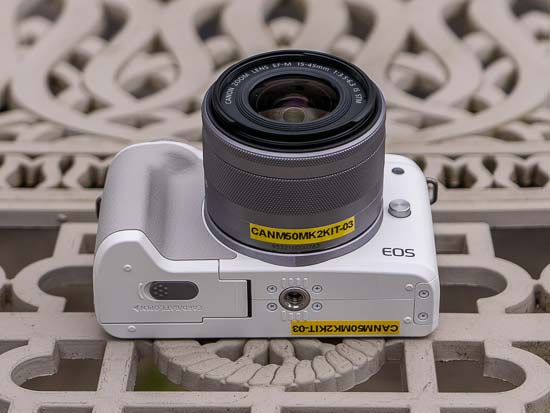
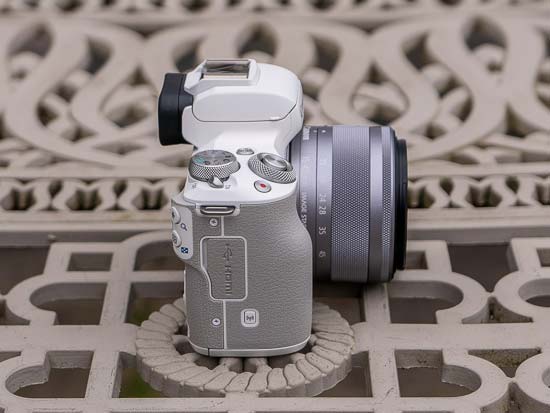
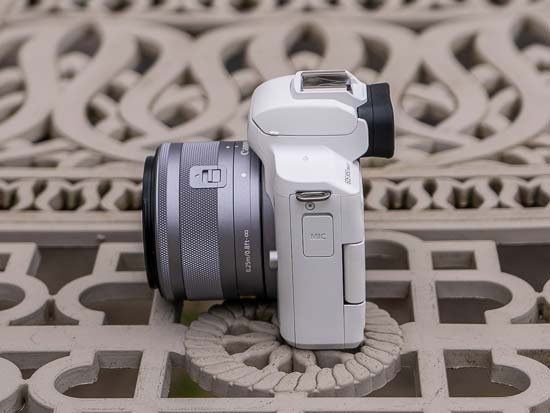
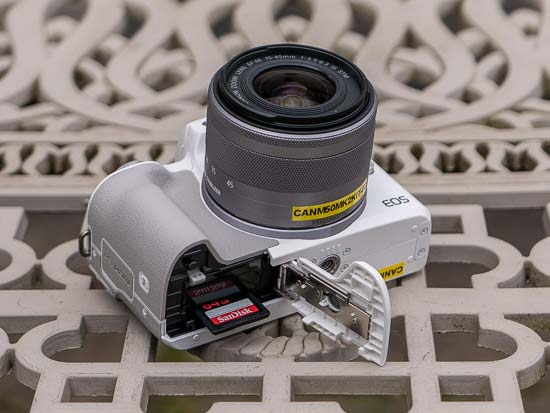

Conclusion
Three years is a long time in the camera industry, but that hasn’t stopped Canon from essentially re-releasing the 3-year-old EOS M50 in 2021 with a slightly different name and the modest addition of a smattering of mainly vlogger-friendly new features.
This would be forgivable or even understandable if those new features addressed some of the key short-comings of the original, but in short, they don’t.
The 2018 M50 was actually the first ever Canon mirrorless camera to offer 4K recording, but just like its predecessor, the Mark II M50 still suffers from the same heavy crop and only having the same contrast-based AF when shooting 4K video, which really makes it a high-quality 1080p camera rather than a 4K one for the majority of users.
As we said in our original M50 review, if you need 4K, look elsewhere, if you only need 1080p, then seriously consider the M50, and that still holds true for the Mark II version.
The handful of new features that Canon have added are virtually all aimed at video content creators, but even together they can’t quite make up for the camera’s crippled 4K mode.
Whether you want to buy an otherwise very capable 1080p video and 24 megapixel stills camera in 2021, just one that isn’t particularly usable for 4K video, is entirely up to you.
The M50 MK II is just as likable as the original model, with an excellent AF system (just not in 4K) benefiting from the addition of Eye-AF tracking, an intuitive touchscreen interface with new video-friendly controls, the versatile vari-angle screen, seamless wi-fi and Bluetooth connectivity, fast burst shooting, and support for vertical video, live streaming and even a clean HDMI output for those who need or want it.
While the price has gone up slightly in the UK and Europe, the EOS M50 II is markedly cheaper than the original version was at launch.
Overall, it’s only really keen videographers that will be attracted by the new features that the Canon EOS M50 Mark II offers when compared to previous version, and even then they may be better served by buying the 3-year-old M50 instead, saving some dollars and spending them on a vlogging kit or a decent microphone instead.
| Ratings (out of 5) | |
|---|---|
| Design | 3.5 |
| Features | 4 |
| Ease-of-use | 4 |
| Image quality | 4.5 |
| Value for money | 3.5 |
Main Rivals
Listed below are some of the rivals of the Canon EOS M50 Mark II.
The Canon EOS 850D is that rare thing – a new DSLR camera in 2020. In a world where mirrorless cameras rule (well, almost), can the Canon 850D still cut it? Find out now by reading our in-depth Canon EOS 850D review, complete with full-size sample photos and videos.
The Canon EOS M200 is an interchangeable lens camera aimed at new photographers. The M200 offers 24.1 megapixels, 4K video recording, a 180-degree tilting LCD and a touch-screen interface. Read our in-depth Canon EOS M200 review now to find out if it’s the perfect camera for beginners…
The Canon EOS M50 is a surprisingly capable mid-range mirrorless camera, at least on paper, offering a specification list that in many ways out-does the company’s flagship M5 model. Does it live up to it’s full potential though? Find out by reading our Canon EOS M50 expert review…
The Canon EOS M6 Mark II is a new mid-range mirrorless camera with a 32 megapixel APS-C sensor, 4K video recording, 14fps burst shooting, a tilting touchscreen and optional electronic viewfinder. Can it beat the likes of the Sony A6400 and Fujifilm X-T30 cameras? Find out now by reading our Canon EOS M6 Mark II review…
Bridging the gap between complete photography beginner and more experienced enthusiast has often proved to be a tricky task for camera manufacturers. The new Fujifilm X-T200 aims to do exactly that, sitting between the entry-level X-A7 and the higher-end X-T30 in Fuji’s mirrorless camera range. Does it succeed in appealing to two quite different kinds of user? Find out now by reading our in-depth Fujifilm X-T200 review, complete with full-size sample images and videos.
Dubbed the Little Giant by Fujifilm, the new X-T30 mirrorless camera takes most of the things that we loved about the flagship X-T3 and packages them into a smaller, lighter body. It even has a few tricks up its sleeve that the X-T3 doesn’t currently offer, most notably a more advanced auto-focusing system. Read our Fujifilm X-T30 review to find out how it compares to the X-T3 and the previous X-T20, and why you should definitely consider buying this new mid-range mirrorless camera…
The new Olympus OM-D E-M10 IV is the successor to 2017’s E-M10 III camera, principally adding a flip-down LCD screen, 20 megapixel sensor, 15fps burst shooting, better continuous auto-focusing and USB-C charging. Find out how it performs in our Olympus EM10 IV review, complete with with full-size sample photos and videos.
The PEN E-PL10 is the latest version of Olympus’ entry-level mirrorless camera. Aimed at smartphone upgraders and beginners, is it the perfect introduction to the world of more serious photography? Find out now by reading our in-depth Olympus PEN E-PL10 review, with full-size sample images and videos…
Hot on the heels of the Sony ZV-1 comes another camera aimed directly at vloggers and Youtubers in the shape of the Panasonic Lumix G100. This time it’s a mirrorless interchangeable lens model, rather than a compact with a fixed lens. The tiny Lumix G100 also has a lot to offer stills photographers too – find out if it can make the grade in our in-depth review…
The Sony A6100 is a new entry-level mirrorless camera that features the fastest auto-focusing system in the world. With a 24.2 megapixel APS-C sensor, 4K movie recording, a tilting OLED screen, electronic viewfinder and built-in flash, the Sony A6100 also offers 11fps burst shooting, bluetooth, wi-fi and NFC connectivity, and USB charging. Read our Sony A6100 review now to find out if it’s the perfect camera for photography beginners…
Specifications
Image Sensor
- Type 22.3 x 14.9mm CMOS
- Effective Pixels Approx. 24.1 megapixels
- Total Pixels Approx 25.8 megapixels
- Aspect Ratio 3:2
- Low-Pass Filter Built-in/Fixed
- Sensor Cleaning EOS integrated cleaning system
- Colour Filter Type Primary Colour
Image Processor
Lens
Focusing
- Type Dual Pixel CMOS AF System. Phase detection pixels built onto imaging sensor
Contrast detection method is used during 4K Movie Servo AF
- AF System / Points Maximum 3975 positions
Maximum 143/99 points available for automatic selection in Face+Tracking mode. May vary depending on settings.
Max 25 frames in Zone AF
Freely position 1 AF point/ 1 AF Zone via manual selection (area available lens dependent)
- AF Working Range EV -4 – 18 (at 23 °C, ISO 100, with EF-M 32mm f/1.4 STM)
- AF Modes One-Shot AF and Servo AF
- AF Point Selection Face + Tracking: Face and subject tracking via automatic recognition/ manual selection via touchscreen. Automatic selection over AF points when no face recognised within frame.
Eye AF available
Zone AF: Manual zone selection, plus automatic selection over AF points within selected zone
1-point AF / Spot AF: Manual selection via touchscreen/ buttons
- Selected AF Point Display Indicated on LCD monitor/ EVF
- AF Lock Locked when shutter button is pressed half way or customisable AE Lock Button
- AF Assist Beam via LED assist beam
- Manual Focus With EF & EF-S lenses – Select via AF/MF switch on lens
With EF-M lenses – Select via dedicated MF Button/ other customisable buttons (toggle AF/MF).
MF Peaking available
AF+MF available (Manual focus adjustment after One-Shot AF)
Magnify image available during MF (5x or 10x)
Exposure Control
- Metering Modes Real-time metering from the image sensor
(1) Evaluative metering (384 zones)
(2) Partial metering at center (approx. 5.8% of Live View Screen)
(3) Center weighted average metering
(4) Spot metering (approx. 2.9% of Live View Screen)Partial and spot metering not available in movie
- Metering Brightness Range Still image: EV -2 – 20 (at 23 °C, ISO 100)
Movie: EV 0 – 20 (at 23 °C, ISO 100) - AE Lock Auto: In One-shot AF mode with evaluative metering exposure is locked when focus is achieved.
Manual: By AE lock Button in creative zone modes. - Exposure Compensation +/-3 EV in 1/3 stop increments
- AEB 3 shots, +/- 2 EV, 1/3-stop increments (can be used together with Exposure Compensation)
- ISO Sensitivity ISO AUTO (minimum 100, maximum can be set between 400 – 25600 except in Scene Intelligent Auto and Creative Filter mode max 6400, and Flash On 1600), 100 – 25600 in 1/3 stop increments. ISO can be expanded to 51200
4K Movie: ISO AUTO (100 – 6400), 100 – 6400 in 1/3-stop increments. Full HD and HD Movie: ISO AUTO (100 – 12800), ISO 100 – 12800 in 1/3-stop increments. ISO can be expanded to 25600
Shutter
- Type Electronically controlled focal-place shutter
- Speed 30 – 1/4000 sec (1/3 stop increments), Bulb (Total shutter speed range. Available range varies by shooting mode)
White Balance
Viewfinder
- Type 0.39-type OLED Electronic Viewfinder
Approx. 2,360,000 dots - Coverage (Vertical/Horizontal) Approx 100%
- Eyepoint Approx 22mm
- Dioptre Correction Yes
- Viewfinder Information Customisable and toggle via INFO. Button
(1) Liveview image with exposure info
(2) Liveview image with basic info
(3) Liveview image with full infoCustomisable settings:
Grid overlay (x3 formats), Histogram (Brightness/ RGB), Electronic Level, Multi aspect ratios - Depth of Field Preview Yes
LCD Monitor
- Type 7.5 cm (3.0”) Touchscreen LCD (TFT). 3:2 aspect ratio. Approx. 1,040,000 dots. Electrostatic capacitive type. Vari-Angle
- Coverage Approx 100%
- Brightness Adjustment Adjustable to one of seven levels
- Display Options Customisable and toggle via INFO. Button
(1) Liveview image with exposure info
(2) Liveview image with basic info
(3) Liveview image with full infoCustomisable settings:
Grid overlay (x3 formats), Histogram (Brightness/ RGB), Electronic Level, Multi aspect ratios, Hints and Tips
Flash
- Built-in Flash GN (ISO 100, meters) 5
- Built-in Flash Coverage Maximum coverage at approx. 15mm (35mm equivalent: approx. 24mm)
- Built-in Flash Recycle Time Approx. 3 seconds
- Modes Auto (E-TTL II)
- Red-Eye Reduction Yes
- X-Sync 1/200 sec
- Flash Exposure Compensation +/- 2 EV in 1/3 increments
- Flash Exposure Lock Yes
- Second Curtain Synchronisation Yes
- HotShoe / PC Terminal Yes/No
- External Flash Compatibility E-TTL II with EX series Speedlites, wireless multi-flash support
- External Flash Control Via camera setting/ flash setting menu
Shooting
- Modes Scene Intelligent Auto, Hybrid Auto, Creative Assist, SCN(Self-Portrait, Portrait, Smooth Skin, Landscape, Sports, Close-up, Food, Panning, Handheld Night Scene, HDR Backlight Control, Silent Mode), Creative Filters (Grainy B/W, Soft Focus, Fish-eye Effect, Water painting effect, Toy camera effect, Miniature effect , HDR Art standard, vivid, bold, embossed), Program AE , Shutter priority AE, Aperture priority AE, Manual exposure, Movie (Movie auto exposure, Movie manual exposure, Time-lapse movie)
- Picture Styles Auto, Standard, Portrait, Landscape, Fine Detail, Neutral, Faithful, Monochrome, User Defined (x3)
- Colour Space sRGB and Adobe RGB
- Image Processing Highlight Tone Priority (standard and enhanced)
Auto Lighting Optimizer (4 settings)
Long exposure noise reduction
High ISO speed noise reduction (4 settings + Multi Shot NR)
Lens peripheral illumination correction
Chromatic aberration correction
Diffraction correctionCreative Assist:
Presets
Background Blur (5 settings)
Brightness (19 levels)
Contrast (9 levels)
Saturation (9 levels)
Color Tone 1 & 2 (19 levels)
Monochrome (Off/Black and white/Sepia/Blue/Purple/Green) - Drive Modes Single, High-Speed Continuous, Low-Speed Continuous, Self timer (2s, 10s, Remote)
- Continuous Shooting One shot AF: Approx. 10 shots/sec for up to 36 frames in JPEG and 10 frames in RAW
Live View Mode
- Coverage Approx. 100% (horizontally and vertically)
File Type
- Still Image Type JPEG: Fine, Normal (Exif 2.31 compliant) / Design rule for Camera File system (2.0)
RAW: RAW (CR3 14-bit),
Digital Print Order Format [DPOF] Version 1.1 compliant - RAW+JPEG Simultaneous Recording Yes, RAW + various JPEG compression possible
- Image Size RAW: (3:2) 6000 x 4000, (4:3) 5328 x 4000, (16:9) 6000 x 3368, (1:1) 4000 x 4000
JPEG 3:2: (L) 6000 x 4000, (M) 3984 x 2656, (S1) 2976 x 1984, (S2) 2400 x 1600
JPEG 4:3: (L) 5328 x 4000, (M) 3552 x 2664, (S1) 2656 x 1992, (S2) 2112 x 1600
JPEG 16:9: (L) 6000 x 3368, (M) 3984 x 2240, (S1) 2976 x 1680 (S2) 2400 x 1344
JPEG 1:1: (L) 4000 x 4000, (M) 2656 x 2656, (S1) 1984 x 1984, (S2) 1600 x 1600 - Folders New folders can be created and selected
- File Numbering (1) Continuous, Auto Reset
(2) Manual Reset
EOS Movie
- Movie Type MP4 [Video: MPEG-4 AVC/H.264, Audio: MPEG-4 AAC-LC (stereo)]
- Movie Size 4K – 3840 x 2160 (23.98, 25 fps)
Full HD – 1920 x 1080 (59.94, 50, 29.97, 25, 23.976 fps)
HD – 1280 x 720 (119.9, 100, 59.94, 50 fps) - Movie Length Max duration 29min 59sec, Max file size 4GB
Other Features
- Custom Functions 9 customisable buttons
- Metadata Tag User copyright information (Author’s Name, Copyright Details)
Image rating (0-5 stars) - Playback Zoom 15 steps plus smooth pinch-to-zoom
- Display Formats (1) Single image with information (toggle options)
(2) Single image
(3) Index display (4/9/36/100 images)
(4) Jump Display (1/10/custom number image, by shot date, by rating, by folder, by movies only, protected only) - SlideShow Playback time: 1/2/3/5/10/30 seconds
Repeat: On/Off
Transition Effects: Off, Slide in 1-2, Fade 1-3 - Histogram Brightness/ RGB
- Highlight Alert Yes
- Image Erase Protection Erase: Single image, Selected images, Selected range, All images
Protection: Selected images, Selected range, All images. Unprotect all images - Menu Categories (1) Shooting menu (x8)
(2) Playback menu (x4)
(3) Setup menu (x5)
(4) Display menu
(5) My Menu - Menu Languages 29 Languages
English, German, French, Dutch, Danish, Portuguese, Finnish, Italian, Norwegian, Swedish, Spanish, Greek, Russian, Polish, Czech, Hungarian, Romanian, Ukrainian, Turkish, Arabic, Thai, Simplified Chinese, Traditional Chinese, Korean, Malay, Vietnamese, Indonesian, Hindi, Japanese - Firmware Update Firmware update possible by the user.
Interface
- Computer Hi-Speed USB (Micro USB)
- Other Wireless LAN (IEEE802.11b/g/n), (2.4 GHz only, 1-11 ch), with Dynamic NFC support
Bluetooth® (Specification version 4.1, Bluetooth low energy technology),
HDMI (Micro – Type-D connector), HDR output to compatible TV supported
Direct Print
- Canon Printers Canon Compact Photo Printers and PIXMA Printers supporting PictBridge
- PictBridge Canon Compact Photo Printers and PIXMA Printers supporting PictBridge
Storage
- Type SD, SDHC, SDXC (UHS-I compatible)
Supported Operating System
- PC See support pages for up-to-date information
- Macintosh See support pages for up-to-date information
Software
Power Source
Accessories
Physical Specifications
- Body Materials Polycarbonate
- Operating Environment 0 – 40 °C, 85% or less humidity
- Dimensions (W x H x D) 116.3 x 88.1 x 58.7mm
- Weight (Body Only) Approx 387g (black), 388g (white), CIPA testing standard including battery and memory card
- Dual Pixel CMOS AF – AF is possible over an area of approx. 80% Vertical x 80% Horizontal of the frame
- Maximum number of AF frame is dependent on selected image aspect ratio
- Continuous shooting speed is measured with EF-M 15-45mm f/3.5-6.3 IS STM and requires SDHC/SDXC UHS Speed Class 1 memory card. Total number of frames captured and continuous shooting speed may vary depending on camera exposure settings, type of lens used, battery level, light level and memory card used.
- Wi-Fi use may be restricted in certain countries or regions.
- Equipped with Bluetooth® low energy technology. The Bluetooth® word mark and logos are registered trademarks owned by the Bluetooth
- Bluetooth functionilty with Camera Connect app requires smart device to be equipped with Bluetooth version 4.0 (or later). Also requires smart device to be using operating system iOS 8.4 (or later) or Android 5.0 (or later)
- Bluetooth functionilty with Camera Connect app requires smart device to be equipped with Bluetooth version 4.0 (or later). Also requires smart device to be using operating system iOS 8.4 (or later) or Android 5.0 (or later)
- Based on the CIPA Standard and using the batteries and memory card format supplied with the camera, except where indicated
- Based on the CIPA Standard and using the batteries and memory card format supplied with the camera, except where indicated
News
First announced in the USA over 5 months ago, the Canon EOS M50 Mark II APS-C mirrorless camera has now been launched in the UK, Europe and Australia.
Don’t get too excited though – it seems to be exactly the same camera in terms of hardware as the original EOS M50 that we reviewed in 2018, just with different firmware that improves the autofocusing, enables the capture of vertical video, adds some new touchscreen controls, and allows wireless live streaming to YouTube.
We’re not quite sure why Canon couldn’t have added these new software features to the original M50 via a firmware update – but if you’re still interested, the Canon EOS M50 Mark II will be available from the end of March 2021 priced at £589.99 / €659.99 body only.
Canon UK Press Release
Canon EOS M50 Mark II – Key Features:
• Create and share content to any platform through Wi-Fi and Bluetooth connectivity
• Capture vertical videos to post direct to social channels
• Clean HDMI output for direct livestreaming from YouTube
• 24.1MP APS-C sensor for stunning images and Full HD video
• Versatile Vari-Angle touchscreen display for multiple shooting options
• A 3.5mm microphone input for professional sound quality
• Lens compatibility to match all perspectives and styles
Canon launches EOS M50 Mark II as social content creation continues to soar
Create standout content with this versatile mirrorless camera, packed with smart features and stunning image quality
London, United Kingdom, 25th February 2021 – In response to the growing demand for high-quality camera equipment to meet the evolving requirements of today’s content creators, Canon Europe today announces the EOS M50 Mark II, the successor to the award-winning EOS M50. The global appetite for creating, sharing and watching content on Instagram, YouTube and Twitch shows no sign of slowing down – with people dedicating more time exploring hobbies and learning new skills. In Europe[i] alone, between Q3 2019 and Q2 2020, TikTok saw its monthly usage increase by 93 per cent amongst 16-64 years olds.
A small, yet powerful mirrorless camera, the EOS M50 Mark II makes the entire process from shooting to uploading content easier than ever before. Capable of capturing landscape and vertical 4K video or livestreaming Full HD directly to YouTube[ii], this camera enables creators to take their content to the next level. With a 3.5mm microphone input, clean HDMI and USB output, this camera has all the inputs and outputs a content creator could need. Its compact body, vari-angle touchscreen and compatibility with a range of Canon lenses means users have complete creative freedom – whether they are capturing beautifully framed ‘to camera’ pieces or are vlogging on the go.
Versatility sits at the heart of this camera. Whether you want to capture high-quality photos for Instagram reels, a native vertical video to share on TikTok, or live stream to YouTube, the EOS M50 Mark II has it covered. With its clean HDMI output, users can create professional-looking live streams and thanks to Canon’s free EOS Webcam Utility Software, casual streaming on Twitch or quality video chats with friends and family is all possible.
Meeting the demand for fast-to-market content, the EOS M50 Mark II boasts enhanced mobile connectivity[iii] via Wi-Fi and Bluetooth. This allows control from a mobile device and direct upload of images and movies to social media channels, ensuring they never miss a beat.
Whatever their style or needs, with built-in microphone import, this portable camera can be easily carried around or even mounted onto a gimbal – giving users flexibility. Whether in front of the camera or behind it, the vari-angle touch screen and responsive electronic viewfinder (EVF) also mean users can frame the shot in any situation.
With over 300,000 stories posted to Instagram every minute[iv], the key to making content stand out is quality. The EOS M50 Mark II allows content creators to use Canon’s EF-M lens range and EF lenses with a mount adaptor, which includes an ultra-wide lens, perfect for vlogging or a lens with a shallow depth of field to get those selfies just right.
The camera’s speed[v], 24.1 megapixel APS-C sensor, Intelligent Auto modes and Eye Detection also gives content creators the edge when it comes to photography – making it possible to take sharp action shots that catch social media scrollers’ eyes. But it’s not just visual quality that will help users’ content gain more views and followers, audio quality is also important. The Canon EOS M50 Mark II has a 3.5mm microphone port, so aspiring YouTubers can create vlogs with impeccable sound quality.
Perfect for vloggers, bloggers and influencers, the Canon EOS M50 Mark II is the ideal choice for content creators requiring stunning image quality, smart features and to live stream to an on-line audience in real-time.
The Canon EOS M50 Mark II will be available from the end of March 2021, but can be pre-ordered from today. For more information, please visit: https://www.canon.co.uk/camera…
The Canon EOS M50 Mark II body retails at £589.99 / €659.99.
Image Gallery
Click on a thumbnail to see the full version.
